Saxony-Anhalt (Sachsen-Anhalt) is a state of Germany. Located in the central part of Germany it is one of the five German states that used to belong to former East Germany. It is bordered by the states of Brandenburg to the north and east, Saxony to the south-east, Thuringia to the south and Lower Saxony to the west. Pretty centrally located within Germany, the region is rich in historical and cultural monuments, especially from the Middle Ages, boasting the highest density in World Cultural Heritage sites among German states.
Cities
[edit]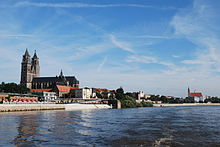
- 1 Magdeburg, state capital on the river Elbe, huge early Gothic cathedral and one of Germany's most important Romanesque monasteries; most of the once glorious old town was however destroyed during World War II
- 2 Dessau, centre of the Dessau-Wörlitz Garden Realm, seat of the 1920s Bauhaus art school, capital of classical modern architecture
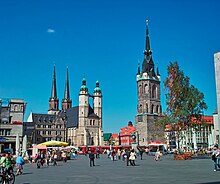
- 3 Halle, the state's most populous city, rich in history, interesting old town, birth place of George Frideric Handel (born Georg Friedrich Händel)
Minor cities and towns:
- 4 Blankenburg
- 5 Eisleben, birthplace of Martin Luther
- 6 Halberstadt
- 7 Lützen, site of a major battle during the Thirty Years War
- 8 Merseburg, more than thousand-year-old town with interesting old centre, Romanesque/Gothic cathedral and Renaissance palace
- 9 Naumburg, late-Romanesque cathedral with remarkable medieval sculptures, one of Germany's oldest boarding schools, home town of Friedrich Nietzsche, several romantic ruined castles in the vicinity
- 10 Osterwieck
- 11 Quedlinburg, remarkably well-preserved medieval old town
- 12 Stendal, capital of the Altmark region, well-preserved medieval old town
- 13 Stolberg
- 14 Thale
- 15 Wernigerode
- 16 Wittenberg, important city during the late Middle Age and Renaissance, origin of Martin Luther's Protestant Reformation
- 17 Zeitz
Other destinations
[edit]Understand
[edit]
The state of Saxony-Anhalt is quite young as a territory, but deeply rooted in history. It was created in 1945 by the merger of some former Prussian territories around Magdeburg in the northern and western parts, the former Duchy of Anhalt in the central part, and old Saxon territories, which came to Prussia as a result of the Vienna Congress in 1815, around Halle and Wittenberg in the eastern and southern parts. Therefore Saxony-Anhalt lacks a centralised structure and many important sites are scattered around the state.
Saxony-Anhalt was a very early centre of settled civilization owing mostly to its very fertile loess soils as can be seen through archeological discoveries such as the neolithic Goseck circle (that probably served as an early solar observatory) and the Nebra sky disk, an astronomical masterpiece of the Bronze Age.
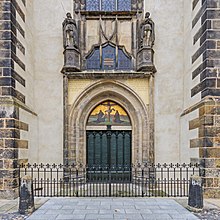
During the age of migrations, the Germanic inhabitants of the area went westward leaving space for Slavic settlers as evidenced by some place names. However, starting from Magdeburg, German colonisation of the East started in the Early and High Middle Ages. During that time impressive feats of architecture like the Romanesque cathedrals in Magdeburg, Naumburg, Merseburg and Halberstadt, the city of Quedlinburg, the castle of Querfurt and numerous monasteries were built in what was a centre of the Ottonian dynasty. Otto I, first holder of the title of (West) Roman emperor since the end of the Carolingian dynasty and widely considered by later generations as one of the first "German" rulers, was buried in Magdeburg.
Perhaps the most famous resident of what is now Saxony Anhalt was Martin Luther. A native of Eisleben, he studied law at first, but wound up in a monastery, and became embroiled in a theological dispute over the sale of indulgences on which Luther (by then a fairly well known professor of theology at the university in Wittenberg) famously published 95 theses written in Latin in 1517, which he may or may not have nailed to the door of the Schlosskirche in Wittenberg as well. Regardless, the conflict - with both sides making ample use of the printing press – ultimately got out of hand and what started as a minor theological debate ultimately split Christianity in twain (Protestant Reformation), with Saxony Anhalt a largely Lutheran area well into GDR times when state-mandated secularism took over. Regardless of religion, many people are proud of the reformatory heritage and both Eisleben and Wittenberg have officially added "Lutherstadt" (Luther city) to their long form names.
Starting from the era of reformation, Magdeburg became a proud city largely independent of any other power and could openly flaunt the emperor who wanted to impose both Catholicism and taxation upon the city. In the Thirty Years War the Catholic side brutally sacked the city in May 1631 and reduced the once proud city of 30,000 to barely a hamlet of a few hundred. Magdeburg never fully recovered and only reached similar population figures during industrialisation. The atrocities of the sack were so bad that even many contemporary Catholics were horrified and magdeburgisieren ("Magdeburg-ify") briefly entered the lexicon as a term for a particularly brutal siege and sack. In 1632, Lützen in southern Saxony-Anhalt was the site of a major battle. It was a pyrrhic victory for Sweden at the cost of thousands of soldiers killed in action and both the Swedish king Gustavus Adolphus and the imperial general Pappenheim mortally wounded. After the war, the mayor of Magdeburg Otto von Guericke became a household name for his experiments with vacuums and the Magdeburg university today bears his name.
The ruling family of the Duchy of Anhalt, formerly an independent territory within Germany, did their share of networking to European monarchies. Roots of the Dutch kings are at Oranienbaum; a princess from Zerbst married to the Russian court and became the Russian tsarina Catharine the Great. Later the city of Dessau and its surroundings emerged as a major hotspot of European enlightenment under Prince Leopold III Frederick Franz, who created the Dessau-Wörlitz Garden realm. The area around Mansfeld has several hundred years of continuous history of mining of copper and other metals.
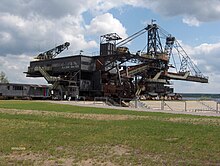
The region was in the geographic centre of the German Empire (before Germany lost its eastern territories and its centre of gravity shifted to the west). It was one of Germany's granaries and industrial power houses, especially regarding chemical industries. Major industrial inventions include the metal airplane by Hugo Junkers (1915) and the colour film at the Agfa-works in Wolfen (1932). Given Germany's lack of oil and gas, both Nazi and Communist leaders encouraged the synthesis of chemicals based on lignite, which was also East Germany's main source of energy. Some areas in the south of the state were therefore transformed into "moonscapes" by the shovels of giant strip-mining excavators digging for brown coal. These open-cast mines have been recultivated and converted into lakes and parks.
Saxony-Anhalt's population has experienced a massive decline as a result of the economic changes in East Germany since unification, leaving suburbs in many cities derelict. Handling shrinking cities is a challenge in urban planning. However, this particularly hits small cities and rural areas whereas major cities like Halle have bounced back from heavy losses in the early 1990s and now experience a minor growth in population again.
Generally, the state massively undersells its historic and touristic potential, which gives room for many discoveries of hidden treasures.
Tourist information
[edit]- Saxony-Anhalt tourism website
Talk
[edit]The language of communication is, not surprisingly, German. Though not as strong as in Saxony or in Bavaria, regional dialects do occur. When meeting visitors from outside their region, most people will make an effort to speak standard German.
As learning English was not compulsory in communist East Germany, do not expect people who went to school before 1990 to speak or understand English, whereas younger people should at least understand some basics. Russian, French, Spanish and other languages are also commonly taught as second foreign languages (after English) in high-schools though results vary dramatically. As Magdeburg and Halle (Saale) are university towns, you may have more luck with various foreign languages there, especially among young people. Your best bet after German would still be English in almost all instances and locals will usually try halting English once they notice you are not a German native speaker. Insist on German (politely but firmly) if you wish and they will usually oblige.
Get in
[edit]By plane
[edit]The Leipzig-Halle Airport (LEJ IATA), just across the border in Saxony, offers connections to most other German and some European destinations. LEJ has a direct train connection to Halle, Köthen and Magdeburg, with interchanges to nearly all areas of the state from there.
Also within reasonable distance (approx. 2 hours) are the airports of Hanover (HAJ IATA) and the new Berlin Brandenburg Airport BER IATA which has the widest choice of international destinations.
The main hubs in Germany, Frankfurt airport (FRA IATA) and Munich airport (MUC IATA), are about four to five hours away.

By train
[edit]ICE high-speed trains on their way from Berlin and Hamburg to Frankfurt or Munich (and back) stop in Halle once or twice an hour. Halle is therefore this state's main rail hub. The trip from Berlin to Halle takes about 1 hr 10 min. Some trains on this route additionally stop in Bitterfeld. The other ICE line (Berlin–Hanover–Cologne), passing through northern Saxony-Anhalt, is usually served without a stop in this state, bypassing the capital Magdeburg.
The second main line accessing Saxony-Anhalt is the intercity route Dresden–Leipzig–Hanover that is served hourly (every other train coming from either Dortmund and Cologne or Bremen) with stops in Halle, Köthen and Magdeburg. Moreover, intercity trains of the Berlin–Hanover–Amsterdam route stop in Stendal in the state's far north at two-hourly intervals.
The privately-owned Harz-Berlin-Express (HBX) runs only on the weekends, linking Berlin with Magdeburg and the Harz mountain region (Halberstadt, Wernigerode, Quedlinburg, Thale). Fares are much cheaper than the regular Deutsche Bahn tickets.
Travelling to other places requires a transfer to regional trains that connect all notable towns at hourly or two-hourly intervals.
By bus
[edit]As of 2014, only a few long distance buses serve Saxony-Anhalt. There are some buses calling at Magdeburg en route from Ruhr Area - Hanover to Berlin, at Halle (Berlin - Munich or Dresden - Kassel). Flixbus serves some smaller places with services Berlin - Halle - Merseburg - Weissenfels - Zeitz (-Gera) and Berlin - Magdeburg - Bernburg - Aschersleben - Wernigerode (-Goslar/Göttingen). Most bus services run once a day only, some even fewer. For more information on the very volatile market see domestic bus travel in Germany
By car
[edit]Likewise, Saxony-Anhalt is well connected to the German Autobahn-grid. Nearly every traveller to Berlin passes through Saxony-Anhalt. Main Motorway east-west is the A 2 (Berlin–Hanover and beyond), which serves the north. Further south is B 6n, dual-carriageway from Bernburg to Goslar and beyond, extension from Bernburg to Köthen being under construction and the A 38 Halle–Göttingen. In the north-south-direction there is the A 9 (Berlin–Munich), which cuts the eastern and southern parts of Saxony-Anhalt (Dessau, Wittenberg, Halle, Naumburg). The A 14 (Dresden–Magdeburg) runs through central parts of Saxony-Anhalt and the A 71 (Sangerhausen– (Erfurt)–Schweinfurt), once completed, will connect to Thuringia and northern Bavaria, the last 20 km between Sangerhausen and Erfurt still missing.
Of course, there are plenty of minor roads connecting to any direction.
By boat
[edit]There are no scheduled boat transfers to Saxony-Anhalt. However, some river cruises use the Elbe when cruising Hamburg–Dresden or Potsdam–Prague, usually stopping at Magdeburg, Dessau and Wittenberg.
Get around
[edit]By car
[edit]There is a dense grid of (mostly) well maintained roads, which serve every spot of the state. Next to the motorways (see get in) are trunk roads ("Bundesstraßen", named B xxx). Standard for trunk roads is single carriageway, though there are also some dual carriageway like the newly built B 6n, Bernburg–Ilsenburg and beyond to Goslar, which has motorway-standard. Other trunk roads like B 81 from the A 2 near Magdeburg towards the Harz, the B 100 from the A 9 near Bitterfeld to Halle and continuing eastwards as B 80 and southwards as B 91 are dual carriageway, but not grade separated and not necessarily bypassing villages. Newly built trunk roads are bypassing at least smaller places.
Some minor roads may still have cobblestone surface or even dirt shoulders. Also there still can be surfaces of slag pavers. Be careful, those can become very slippery, when wet.
There are not many bridges crossing the Elbe river (only at Wittenberg, Dessau, Schönebeck, Magdeburg and Tangermünde) and the Saale downriver from Halle, but ferries roughly every 20 km of river length. Ferries may not operate during high water levels, some shut down in winter and they do not have 24/7 service. Usual operating times are from 06:00 to 20:00 weekdays, with shorter times (or even no service) on weekends and holidays. Some ferries are on diesel, others are reaction ferries with a cable firmly attached in the river bed and using the current of the river for movement. The reaction ferries, making no noise but the water bubbling underneath them, are a sight by their own right. However, plan carefully, as there might be a long detour waiting, if they are out of operation.
By train
[edit]There are train services throughout the state to most places of interest. Regional trains operate on an hourly (sometimes two-hourly) basis from approx 05:00 to approx 22:00, sometimes midnight. There are special tariffs for journeys under 50 km on regional trains ("Hopper ticket") for €4.50 flat fare single and €7.50 return. Also there is the Länder-Ticket Sachsen-Anhalt at €30 for one person plus €8 for any additional person up to five. It is valid on any regional and local train plus buses and tramways, which run under an integrated transport authority (like Magdeburg and Halle regions). Saxony-Anhalt-ticket is also valid in Thuringia and Saxony and vice-versa, Saxony-ticket or Thuringia-ticket in Saxony-Anhalt.
By bus
[edit]In addition to the trains, a bus network is part of the "state network" throughout the country. The lines run at least every two hours during the day on weekdays. All bus lines that run on the state network are identified in timetables by the <O> seal. Local fares apply, but rail offers such as Sachsen-Anhalt-Ticket, Schönes-Wochenend-Ticket are recognized in the state network. Holders of BahnCards can travel at reduced rates for children.
In the city of Halle, the Saale district and the Burgenland district, there is the Mitteldeutscher Verkehrsverbund (MDV), and in Magdeburg and the surrounding districts of Jerichower Land, Börde and Salzlandkreis, there is the marego network, in which regional trains, suburban trains, buses and streetcars can all be used with a single ticket. In Dessau-Roßlau and the districts of Wittenberg and Anhalt-Bitterfeld, the MDV fare is only valid on regional trains and commuter trains. In the other regions, there is a confusion of fares that is sometimes not easy to understand.
By bike
[edit]Some long-distance cycling tracks run through Saxonxy-Anhalt like the R 1 or the track along the rivers Elbe, Mulde and Saale. Carrying a bike is free on all local trains and most of the other public transport within Saxony-Anhalt (though not in neighbouring states, so watch out on trains, which cross).
See
[edit]

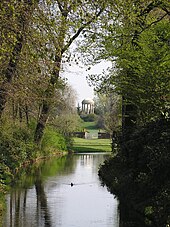

Saxony-Anhalt is Germany's state with the highest density of UNESCO World heritage sites:
- the medieval town of Quedlinburg. More than one thousand half-timbered houses.
- Naumburg Cathedral from the 13th century, at the passage from late-Romanesque to early-Gothic style. The twelve donor figures by the anonymous Naumburg Master are among the most well-made pieces of medieval sculpture.
- the Luther sites at Wittenberg and Eisleben. Protestant reformer Martin Luther was born and died in Eisleben, where his birthplace and death house stand. At the university town of Wittenberg, Luther spent most of his time and (supposedly) nailed his 95 theses at the door of the castle church.
- the Dessau-Wörlitz Garden Realm. Created in the second half of the 18th century, it consists of several landscaped parks.
- the Bauhaus sites at Dessau (and Weimar) from the 1920s, pioneers of classical modern architecture that later became the "International Style" of the 20th century. Dessau has the Bauhaus building, the masters’ houses and several other Bauhaus buildings.
Other sights include:
- medieval cathredrals at Magdeburg, Halberstadt, Quedlinburg, Merseburg; well preserved castles at Falkenstein, Querfurt.
- Europe-Rosarium at Sangerhausen, world’s largest collection of roses.
- The Harz mountains with the highest mountain of northern Germany, the 1141-m Brocken, the Bode canyon and the Rappbode reservoir with the highest dam in Germany.
- the Elbe floodplains, Unesco biosphere reserve.
- two of the northernmost vine-growing areas in Germany around Naumburg and the Süsser See near Halle.
- industrial history like the Röhrigschacht mine near Sangerhausen (mine allowing access down 200 m), the film museum at Wolfen, birth place of the colour film, or the city of iron, Ferropolis near Gräfenhainichen.
Itineraries
[edit]- The Elbe Radweg, one of Europe's most popular cycle routes passes through Saxony-Anhalt: Wittenberg – Wörlitz – Dessau – Magdeburg – Tangermünde – Havelberg
- Romanesque Road, links the many Romanesque cultural monuments (mostly churches, abbeys, and a few castles) all over this state: Magdeburg – Salzwedel – Arendsee – Havelberg – Jerichow – Genthin – Burg – Wanzleben – Oschersleben – Halberstadt – Osterwieck – Ilsenburg – Blankenburg – Qudlinburg – Gernrode – Ballenstedt – Falkenstein/Ermsleben – Eisleben – Sangerhausen – Querfurt – Naumburg – Zeitz – Freyburg – Merseburg – Halle – Landsberg – Petersberg – Bernburg
- Himmelswege ("sky paths") linking places of protohistoric astronomy/astrology: Nebra Ark Visitor Centre (where the Nebra sky disk dating from 1600 BC was discovered) – Halle Museum of Prehistory (where the sky disk is exhibited now) – Goseck solar observatory (49th-century BC neolithic circular enclosure) – megalithic tomb Langeneichstätt
Do
[edit]- cycle along the Elbe.
- cruise the Romanesque Road, a holiday route, which connects more than 80 places of romanesque origin (churches, monasteries, castles), including world class buildings like the Magdeburg or Naumburg cathedrals, but also hardly known village churches.
- ride the narrow-gauge steam trains from Wernigerode up the Brocken or in the Selketal.
- attend one of the numerous music festivals of classical (Handel festival in Halle in June, Johann Sebastian Bach festival in Köthen, Kurt Weill festival in Dessau in February) or modern music (Melt! festival in Ferropolis in July)
Eat
[edit]Drink
[edit]
At the banks of the Saale and Unstrut near Naumburg and Freyburg there are some of the northernmost wine-producing areas in Germany. As for the continental climate with rainfall under and sunshine above the German average and a tendency to poor soils on carbonate rocks, wines tend to become quite intense in taste and alcohol-rich. Rotkäppchen, a producer of budget (yet drinkable) champagne and one of the best known brands of East Germany, has its cellars in this region. Mostly white vines are growing. Outside that area Saxony-Anhalt is mostly beer drinking territory with a large brewery (Hasseröder) near Wernigerode and some smaller ones scattered around.
Sleep
[edit]There is plenty of accommodation across the whole range from hostels to top-class hotels. There might be some busier times regionally, but in general there are enough hotel beds to meet the demand. Reservations are only necessary, if you want a specific hotel on a specific date.Price level is moderate, from around €30 per person per night in standard accommodations to €80/100 per person per night in top-class hotels.
As special hotels there are to mention a hotel on top of the Brocken (highest mountain), a hostel in the original Bauhaus-building in Dessau, All across the region you will find hotels in former manor houses or castles like Meisdorf House, Schloss Altenhausen, Schloss Storkau or Wasserburg Westerburg.
Go next
[edit]Saxony Anhalt is more or less Centrally located and thus hops across the state line take you almost anywhere in Germany
- Thuringia , here your Sachsen-Anhalt-Ticket is valid as well for all regional trains
- Saxony historically both Länder share a lot of common heritage, and big chunks of Saxony-Anhalt were once part of Saxony, before the kings and electors lost one too many wars (they had a propensity for almost always choosing the wrong side). Halle-Leipzig in particular serve as one big metropolis with two cores in some ways, even sharing an airport in Schkeuditz.
- Lower Saxony, the most natural next step if you are interested in medieval history (and not yet tired of castles, cathedrals, monasteries and half-timbered houses)


